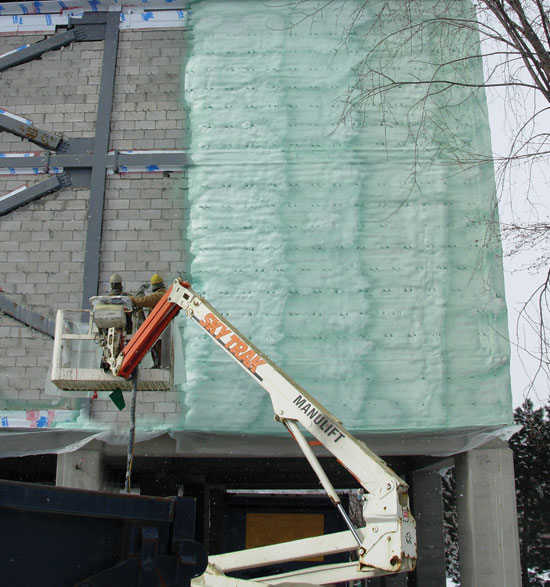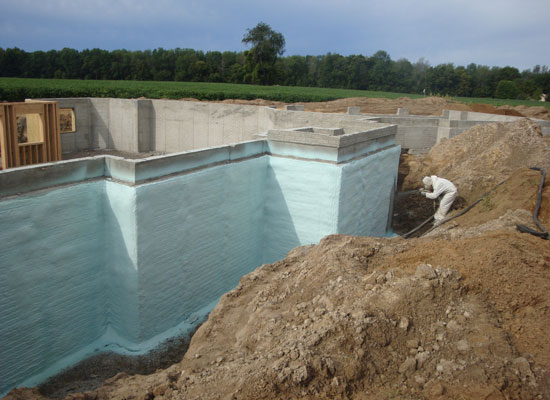Spray Foam Insulation in High Performing Building Designs
Exterior Applications
The number one growing application for closed cell foams are exterior encapsulations, or insulation applied to the outside of wall sheathing or a roof deck. In addition to providing insulation values at desired levels, this exterior application creates complete monolithic control systems on the outside of buildings with no seams, no joints, and no tape.
In exterior walls, medium-density SPF can serve as a four-in-one application, providing an exterior thermal insulation, an air barrier, a vapor retarder, and a drain plane all in a single application. In this case, the SPF would be sprayed on last just before the final cladding material is installed. In the case of a typical brick and CMU cavity wall, it would be installed after the CMU back-up wall had been constructed and brick ties put in place, but before the actual outer brickwork was performed. Because of its more dense and durable nature, medium-density SPF can be left exposed to the elements during a normal construction time frame without experiencing a degradation in performance.
The latest building and energy codes and standards have recognized that it is this continuous insulation layer that improves the overall performance of an exterior wall or roof assembly. They typically give more credit for the effectiveness of this continuous insulation (ci) compared to insulation that is interrupted by studs or other framing members. Further, they recognize that these framing members and other structural elements act as significant “thermal bridges” where there are essentially gaps or holes in the layer of insulation as it is installed around the building. This approach is well founded in building science through both calculated/computer modeled analysis as well as actual testing of assemblies and buildings. Hence, by continuously insulating with SPF over the outside of a stud wall, the temperature difference across the studs is less, thus reducing the rate of heat transfer.
The effectiveness of the exterior insulation application becomes even more pronounced on multistory buildings where a stud wall assembly is used on multiple floors. The studs commonly rest on and get anchored to a floor structure that for example could be 4 to 6 inches of concrete in a metal deck or a 10-inch to 12-inch wood framed structure. In this type of construction, the insulation in the wall studs stops above and below the floor structure, meaning the floor edge is exposed along the full length and width of the building. It is therefore a very significant thermal bridge since there is nothing to prevent heat from being transferred between the inside and the outside of the building along the entire perimeter of the floor construction. The obvious means to overcome this deficiency is to insulate this edge as part of the overall SPF insulation scheme of the building envelope.
The same type of thermal bridging phenomenon occurs elsewhere in the building envelope as well. Structural elements such as columns or beams made of steel or concrete can create very significant thermal breach if they are not insulated on the outside. This applies not only to walls but to roof elements too, such as roof parapets which can act in the vertical plane the same way exposed walls act in a horizontal plane. The ideal solution is to make sure that continuous insulation connects at the critical juncture between wall and roof. Of course, that also implies that the roof and the wall are continuously insulated as well.
 |
SPF applied to the exterior of a multistory wall system provides complete continuous insulation. Photo courtesy of Demilec (USA) LLC |
 |
Medium-density closed cell SPF insulation is effectively used on the exterior of foundation walls or under concrete slabs on grade. Photo courtesy of Demilec (USA) LLC |
Below-Grade and Under-Slab Applications
A conventional below-grade occupied space or a residential basement typically requires multiple layers to control water penetration and heat loss. Commonly, a damp proof or a water proof layer is applied over concrete or CMU on the outside. Insulation is then added either inside or outside. In some cases additional membranes and layers are added to accommodate local design conditions.
By contrast, medium-density SPF insulation can be used on the exterior side of below-grade walls to provide all of the same benefits as above grade walls. The single layer application of foam can provide an effective damp proofing layer, an effective air seal, and a fully continuous insulation layer from the top to the bottom of the wall. For any portion exposed above grade, it will need to be protected from sunlight to prevent discoloration and potential degradation. Individual manufacturers' information will need to be consulted to properly address any of these conditions.
When it comes to under-slab construction, medium-density SPF insulation can provide an effective alternative to the commonly used rigid board insulation. Open cell insulation is not well suited for under-slab construction so using medium-density closed cell insulation is the logical choice since it will help avoid potential problems later on. Since the spray foam can be installed inside formwork and below reinforcing bars it can completely fill the allotted space beneath the slab and seal all edges of formwork or foundation walls. Once it is ready, the concrete can be poured on top of the SPF and the two will form a tight seal together. This can create a superior performance particularly if the slab is heated since the complete, uninterrupted layer of insulation will avoid the problems of multiple joints present when using individual boards. Further, it will provide a full and continuous layer as a vapor barrier between the slab and the ground.









